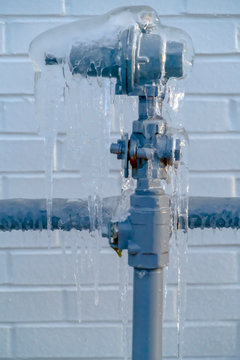We have stumbled on this article relating to Preventing and dealing with frozen pipes listed below on the net and figured it made sense to discuss it with you on this site.
:strip_icc()/snow-outdoor-faucet-pipes-4af65d1e5e904fb1aa7bf74071fe5d89.jpg)
Cold weather can ruin your plumbing, especially by freezing pipes. Here's exactly how to stop it from occurring and what to do if it does.
Intro
As temperature levels decrease, the threat of frozen pipelines increases, possibly causing expensive repair services and water damage. Comprehending how to stop icy pipelines is crucial for house owners in cold climates.
Avoidance Tips
Insulating susceptible pipes
Wrap pipes in insulation sleeves or make use of warmth tape to protect them from freezing temperatures. Focus on pipelines in unheated or outside areas of the home.
Heating methods
Maintain indoor spaces sufficiently heated, especially areas with plumbing. Open cabinet doors to allow cozy air to flow around pipelines under sinks.
Exactly how to recognize icy pipelines
Try to find decreased water circulation from taps, unusual odors or noises from pipelines, and noticeable frost on subjected pipes.
Long-Term Solutions
Architectural modifications
Think about rerouting pipes far from outside walls or unheated locations. Add extra insulation to attic rooms, basements, and crawl spaces.
Upgrading insulation
Buy top notch insulation for pipes, attics, and walls. Correct insulation helps maintain consistent temperature levels and decreases the risk of frozen pipelines.
Shielding Outdoor Plumbing
Garden tubes and outside taps
Separate and drain yard hose pipes prior to winter months. Set up frost-proof faucets or cover outside taps with insulated caps.
Recognizing Frozen Pipelines
What causes pipes to ice up?
Pipelines ice up when revealed to temperatures listed below 32 ° F (0 ° C) for expanded periods. As water inside the pipes ices up, it increases, putting pressure on the pipe wall surfaces and possibly causing them to rupture.
Dangers and problems
Icy pipelines can bring about water disturbances, residential property damages, and costly repair services. Ruptured pipes can flood homes and cause extensive structural damages.
Indicators of Frozen Piping
Determining icy pipes early can prevent them from bursting.
What to Do If Your Pipelines Freeze
Immediate actions to take
If you suspect icy pipelines, maintain faucets open up to eliminate pressure as the ice thaws. Utilize a hairdryer or towels soaked in warm water to thaw pipes gradually.
Final thought
Preventing icy pipes needs aggressive measures and fast feedbacks. By comprehending the causes, indicators, and preventive measures, house owners can secure their plumbing during cold weather.
6 Proven Ways to Prevent Frozen Pipes and Protect Your Home
Disconnect and Drain Garden Hoses
Before winter arrives, start by disconnecting your garden hoses and draining any remaining water. Close the shut-off valves that supply outdoor hose bibs and leave the outdoor faucet open to allow any residual water to drain. For extra protection, consider using faucet covers throughout the colder months. It’s also important to drain water from any sprinkler supply lines following the manufacturer’s directions.
Insulate Exposed Pipes
Insulating your pipes is an effective way to prevent freezing. Pipe insulation is readily available at home improvement stores and is relatively inexpensive. Pay close attention to pipes in unheated areas such as the attic, basement, crawl spaces, or garage. Apply foam insulation generously to create a buffer against the cold. You can also wrap your pipes in heat tape or thermostat-controlled heat cables for added warmth.
Seal Air Leaks
Inspect your home for any cracks or openings that could let in cold air. Seal any holes around the piping in interior or exterior walls, as well as the sill plates where your home rests on its foundation. Additionally, make sure to keep your garage door closed unless you’re entering or exiting. Leaving it open creates a significant air leak that can lead to frozen pipes.
Allow Warm Air Circulation
During cold snaps, it’s essential to allow warm air to circulate evenly throughout your home. Leave interior doors ajar to promote better airflow. Open kitchen and bathroom cabinets to help distribute heat consistently around the rooms. If you have small children or pets, be sure to remove any household chemicals or potentially harmful cleaners from open cabinets for safety.
Let Faucets Drip
A small trickle of water can make a big difference in preventing ice formation inside your pipes. When temperatures drop significantly, start a drip of water from all faucets served by exposed pipes. This continuous flow helps prevent the water from freezing. Additionally, running a few faucets slightly can relieve pressure inside the pipes, reducing the chances of a rupture if the water inside does freeze.
https://choateshvac.com/6-proven-ways-to-prevent-frozen-pipes-and-protect-your-home/

As an avid reader on Helpful Tips to Prevent Frozen Pipes this Winter, I imagined sharing that excerpt was worth the trouble. Are you aware of someone else who is occupied with the niche? Do not hesitate to share it. Thanks a bunch for being here. Return soon.
Go Company
Comments on “Important Tips to Avoid Frozen Pipes in Winter”